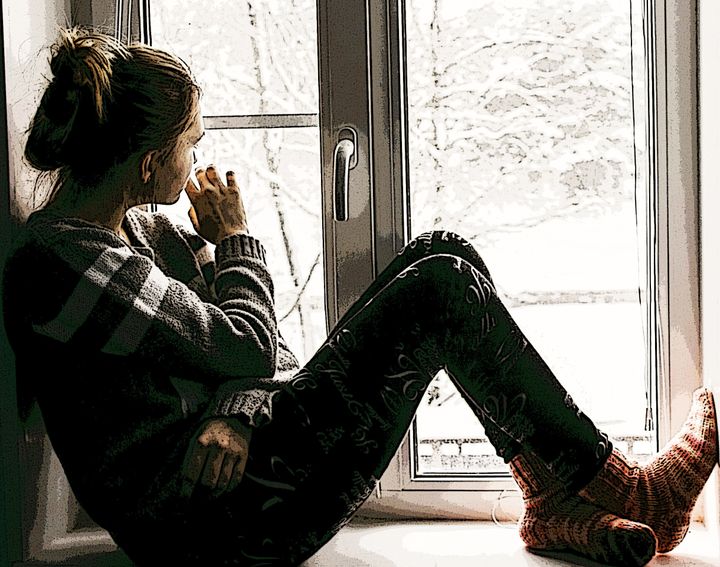As winter creeps nearer and days seem to turn into one long and foreboding night, roughly one in 15 people in the UK are hit by feelings of lethargy and unhappiness on a life-altering scale.
Seasonal affective disorder (SAD) has a huge effect on a person’s mood and energy levels. Although people can be diagnosed at any time of the year, it’s typically prevalent between November and March, according to Anxiety UK, because of the lack of daylight. And while some people need antidepressants to help them cope with the symptoms, for those who relish the cosiness and festivities of winter, it can be hard to understand what life with SAD is really like.
“It’s a negative, heavy and crushing feeling,” says 33-year-old Chelle Shohet, who lives in north Hertfordshire and experiences SAD from mid-September right through to April.
“SAD makes me feel foggy, lacklustre and very irritable. It can leave me feeling like I have no energy or get-up-and-go. It also makes me feel down and depressed and irritated by anything and everything – I cry at the drop of a hat.”

Ella Baker, 26, likens SAD to a feeling of “impending doom” – sometimes it will last all day, at other times it will last for minutes or hours. The writer from Bristol says it tends to creep up at the end of daylight savings (28 October) and crescendos around February and March. At this point, she says, it’s hard to remember a time when she hasn’t felt so down.
Last winter, she hit breaking point and was on the verge of tears constantly. She didn’t have the motivation to do anything or start any new projects, and avoided going out with friends – a situation which lasted as long as two weeks at a time. “I am a very social, active and productive person, so these changes to my mood are very drastic, and do make life feel unbearable,” she explains.
For Baker, SAD feels like there’s a general dullness and sadness in every aspect of her life, even if she’s outwardly enjoying herself. It also impacts her sleep and she finds it hard to drag herself out of bed in the mornings. “I just struggle to face the day,” she adds. “To people who know me it probably seems like there are two people living inside me: the winter me and the summer me.”
SAD impacts all areas of life – whether it’s friendships, romantic relationships, even your job. Baker says it affects her home life and relationships in particular. At work, it can impact her performance as she finds it hard to concentrate.
“I sometimes mess up my tasks and forget to check my work,” she admits. “My motivation is affected so I’m less likely to put myself forward for projects and don’t engage as much. Of course, I do my best not to allow these things to happen.”
Shohet, who works as a women’s coach and stylist, says she has cancelled networking events in the past because she just couldn’t face them – “I wasn’t my normal energetic self and I just became anxious about how I looked and couldn’t speak in a focused, coherent way as I was so foggy.”
Symptoms of SAD
:: Persistent low mood,
:: Loss of pleasure or interest in normal everyday activities,
:: Feeling irritable,
:: Feelings of despair, guilt and worthlessness,
:: Low self-esteem,
:: Tearfulness,
:: Feeling stressed or anxious,
:: Reduced sex drive,
:: Becoming less sociable,
:: Finding it hard to concentrate,
:: Lethargy,
:: Sleeping for longer and finding it hard to get up in the morning,
:: Increased appetite,
:: Being less active than normal.
Coping mechanisms
When a person is in the grips of SAD it can seem like there’s nothing that will help them out of the darkness, but both Baker and Shohet have developed action plans to help themselves – and it’s something they’d definitely recommend to others.
Baker focuses on trying something new each year. Her 2018 goal is to do more with her evenings: “In summer I am often out until 7/8pm in the evening but in the winter I’m more likely to come home at 5pm and do nothing, which isn’t great for my mood. So this winter, I am booking in exercise classes and dates with friends three times a week or more so I can find more positives in my day.
“It will be hard to motivate myself, but I know it will help me.”
She also uses an alarm clock which simulates the sunrise 30 minutes before her alarm, takes vitamin D tablets, exercises daily, eats healthy meals and resists the temptation to snack or over-eat (which causes her to feel groggy).
Shohet, meanwhile, swears by a daily plan which was recommended to her by a doctor and psychologist in New York. Her routine consists of healthy meals, a daily walk outside, meditation and 30 minutes of light therapy. Like Baker, she also tries to avoid foods which are high in carbohydrates as they make her feel more lethargic.
Some people have found comfort in animal therapy – of sorts. Christopher Harris, 45, has lived with SAD for 15 years now and says it often results in him becoming a recluse during the winter months – which is when he has his worst bouts.
His symptoms have eased up over the years and the mature student from Oxford credits his dog for helping him get back on track. “Sasha, my now nearly nine-year-old black Labrador keeps me sane(ish) all year round,” he explains. “She gets me out of the house – come rain, hail, snow or shine – for two hours each day.
“I look forward to our walks together. Do I think I would be here if not for her? Honestly, no.”